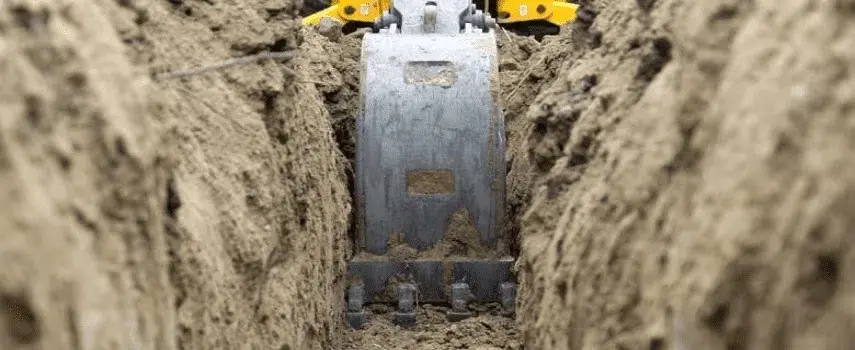Excavation and trenching are among the most hazardous activities in the construction industry. They result in numerous accidents and fatalities every year. Trenches, which are narrow underground passages created to install or repair infrastructure, often create unique dangers due to their depth, narrowness, and proximity to unstable soil. Deaths from trench collapses in the U.S. have skyrocketed over the last decade, with the number peaking at 40 in 2022, up 65% from previous years.
Soil Instability and Cave-ins
The primary risk in trenching is a cave-in, which can happen when the walls of a trench collapse unexpectedly. Soil is usually less stable than it appears, especially after being disturbed by previous excavation activities. The type of soil, moisture content, and trench depth all affect the stability of trench walls. In fact, the Occupational Safety and Health Administration (OSHA) reports that cave-ins are the leading cause of fatalities in trench work. Workers trapped in cave-ins can be buried within seconds, making survival rates low and rescue efforts challenging.
Why soil collapses in trenches:
- Vibrations: Heavy machinery or close traffic can cause vibrations that destabilize soil, increasing the risk of cave-ins.
- Water infiltration: Rain or groundwater can weaken trench walls, leading to soil saturation and eventual collapse.
- Soil type: Different soils have varying stability levels; loose or sandy soil, for example, is more prone to collapse than dense clay or compact soil.
Lack of Protective Systems
Protective Systems such as shoring, shielding, and sloping are critical to maintaining trench stability and protecting workers. Shoring involves using supports to prevent soil movement while shielding uses steel aluminum boxes to create a protected workspace. Sloping involves cutting trench walls at an angle to reduce pressure.
However, due to time constraints, budget limitations, or a lack of awareness, many contractors skip these protective measures, leaving workers exposed to dangerous conditions. According to OSHA, trenches deeper than five feet must have protective systems in place unless the trench is made of stable rock. The absence of these systems is a common factor in trench-related accidents.
Inadequate Inspections and Hazard Assessment
Before beginning trench work, inspections and hazard assessments are essential. An experienced worker – one who can identify potential hazards and has the authority to stop work if conditions are unsafe – should assess the soil, trench depth, and surrounding environment. These inspections must also continue daily and after events like heavy rain or machinery shifts. Unfortunately, many projects overlook these steps, allowing undetected risks to endanger workers.
Limited Worker Escape Routes
When a trench collapses, the lack of an accessible escape route can turn a dangerous situation fatal. Trenches should have ladders or other means of escape within 25 feet of all workers. However, in many cases, these exits are either too far apart or nonexistent, trapping workers inside. In a cave-in, every second matters. Workers without a quick way to escape are more likely to become trapped and injured.
Inadequate Training and Awareness
A lack of training is another leading cause of trench accidents. Workers need to understand the unique hazards of trenching, recognize early warning signs of instability, and know the importance of protective measures. When workers are not properly trained in recognizing these risks, they are less likely to follow safety protocols. Furthermore, supervisors or contractors who lack adequate trench safety training may prioritize deadlines over safety, compromising trench stability and worker security.
Unforeseen Environmental Factors
Environmental factors, such as rainfall, temperature changes, and even nearby construction, can affect trench safety. For instance,, sudden rain can saturate the soil, leading to unexpected cave-ins, while extreme temperatures can expand or contract soil layers, affecting stability. Heavy equipment near a trench also increases soil pressure, which can contribute to collapses. Failure to account for these factors often results in construction accidents that might have been prevented with better environmental awareness.
The Pressure to Meet Deadlines
Construction projects often operate on tight timelines and strict budgets. Under pressure to complete work quickly, some contractors and workers may take shortcuts, such as excluding protective systems or neglecting inspections. This tendence to rush can significantly increase the likelihood of trench accidents. Although time savings might be achieved in the short term, the risks of injury or fatality make these shortcuts unjustifiable.
The Importance of Safety in Trenching
Trenching accidents can have tragic consequences, but they are largely preventable with proper safety measures, training, and awareness. Protective systems, regular inspections, adequate escape routes, and worker education are all essential components of trench safety. By recognizing and addressing the specific risks associated with trenches, companies can safeguard their employees and reduce the alarming number of excavation-related accidents.
Contact Us
If you’ve been injured in a New York construction accident, it’s important to discuss your legal rights and options with a qualified and knowledgeable attorney. Don’t hesitate to contact us at (212) 514-5100 with questions about your construction accident case. We’re here to answer your call 24 hours a day.




